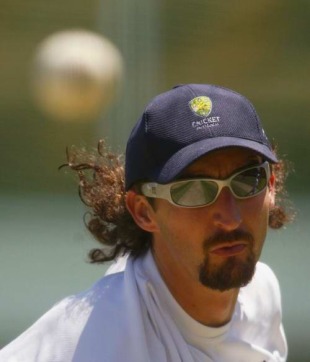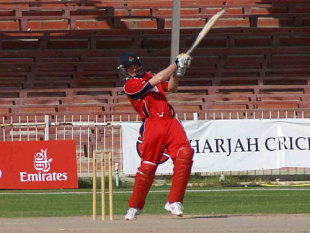|
Gone with the 2000s
What's common to the tubby batsman, Sharjah, and the crowd invasion? They're among the things cricket lost this decade - perhaps never to return

|
|||
|
Related Links
|
|||
The true tailender
Down with the Mitchell Johnsons and the Brett Lees of the world. Give us back our Glenn McGraths. Or at least take away these wannabe allrounders' helmets, chest guards, elbow guards, thigh pads. It is boring to watch a No. 9 play classical straight drives with a high elbow - no fear of the bouncer, no backing away, no nervous grin. No wonder Chris Martin is adored: our only link to a world that once was, where bowlers did their jobs and batsmen theirs.
The fence
We'll never again hear Bill Lawry shout, "He's hit it into the gutter; it's all happening here at the MCG." Because the gutter, and the fence, are gone. Nor are we likely to see the kind of catch that Hrishikesh Kanitkar pulled off to send back Inzamam-ul-Haq in an ODI in Adelaide in 2000. Without the fence, it would definitely have been a six: Kanitkar leaned over the barrier, using it as support, parried the ball back into the field of play and caught it. Even if the fielder touched the fence and the ball at the same time, it wasn't considered a boundary back then; the ball had to either touch the gutter or the fence, or land beyond the fence.
The princely fat batsman
Arjuna Ranatunga left fairly early in the decade, and with Inzi went the last top-level fat batsman, beneath whose dignity it was to scamper for singles and chase the ball with urgency. Jesse Ryder has promise, but his diving saves and catches at gully are a disgrace to the role.
The limping, yorkered batsman
Search Youtube for "Waqar Younis Brian Lara". Chances are almost everyone has seen that particular yorker, from the 1997 Rawalpindi Test, swinging in late and following the toe like a possessed dog. Sadly we don't see batsmen limp back to the pavilion anymore.
The Test allrounder
We still have Jacques Kallis, but Chris Cairns finished with just 62 Tests, Andrew Flintoff with 79, and Abdul Razzaq 46. There is simply too much cricket happening for a proper allrounder to survive, and there is simply too much money in the shorter forms of the game to give up in order to focus on Tests alone. Who after Kallis? We know not. The closest are Shakib Al Hasan and Daniel Vettori: both would have lesser roles to play in stronger teams.
Delhi belly
We don't hear any longer from teams visiting India about upset stomachs or the need to bring along baked beans. Instead we have Brett Lee - that ambassador for world harmony - namaste-ing, singing (if that's the term) in Hindi, the works. If the IPL has had even the slightest role to play in this collective change of attitude towards touring India, it should be stopped immediately.
The red-ball ODI
With day-night cricket came the white ball and coloured clothing. But a few day games - till as recently as India v Zimbabwe in Rajkot in 2000 - with the white clothing and the red ball provided some variety. The red ball definitely swung for longer. But since uniformity and standardising is the name of the limited-overs game, all matches are now played with the white ball.
The intensity of the India-Pakistan rivalry
When India met Pakistan in the 2003 World Cup, Sachin Tendulkar said he had been forced to live the match a year in advance. When India toured Pakistan in 2003-04, 15 years after their last tour there, Atal Behari Vajpayee, then India's Prime Minister, told the team: "Khel hi nahi, dil bhi jeeto [Don't just win the games, win hearts too]." At the end of the decade, amid the overkill, India-Pakistan matches have ceased to be a matter of life and death, or exercises in diplomacy. Chances are, the new generation of players on either side might never know what pressure really means.
The pure wicketkeeper
At various points during this decade, James Foster, Prasanna Jayawardene and Chris Read might have felt like sending out hitmen after Adam Gilchrist, who heralded a complete change in the role of the wicketkeeper of every international team. Purity of skill and aesthetic appeal behind the stumps ceased to matter; runs in front carried more than equal weight. Not to be ignored is the amount of hard work the likes of Gilchrist and MS Dhoni have put in in order to not be liabilities behind the stumps.
The dibbly-dobbly
Yes there are military-medium bowlers around, but they don't quite do it like Chris Harris, who last played international cricket in 2004, used to. Nor might it be possible for dibbly-dobbly bowlers - whose main skill was to cut out scoring areas - to thrive, or even survive, in an era where the batsmen have opened up all parts of the field for scoring.
The crowd invasion
The one after Pakistan beat India in the Champions Trophy earlier this year was an aberration. With the ever-pervasive security these days, it is unlikely we will see many more.
Australia's domination of the Ashes
In this decade alone, England won the Ashes twice - two more times than in the 1990s. While England remained passionate about the series even in the nineties, the rest of the world, especially those whose cricket lives began post 1987-88, was introduced to the oldest rivalry in cricket.

|
|||
|
|
|||
The boring draw in Sri Lanka
Before the start of the year 2000, Sri Lanka had hosted 42 Tests, 20 of which were draws. Over this decade, though, with the rise of Muttiah Muralitharan, Sri Lanka has grown in confidence as a Test nation, and it has shown in the pitches prepared. Only 11 of the 54 Tests in the 2000s ended in draws (a result rate bettered only in Australia and South Africa among the top eight nations). Sri Lanka played out exciting series against Australia, India and Pakistan; and even some of the draws - notable among them the ones that England hung grimly on for in 2003 - were exciting Test cricket.
Sharjah
It all ended in a whimper: Zimbabwe upset Sri Lanka to make the last match of a quadrangular series, but were bowled out for 168 in the final against Pakistan. No one knew then that it would be the last of the 198 ODIs there - still a record expected to stay for at least 10 more years. There are arguments against the venue, like the one India presented in 2001 when barring its team from playing there, but almost every cricket fan has memories of Sharjah.
The dour opener
See off the new ball? A near-10-hour 125, like the one Michael Atherton produced in Karachi in 2000, is not likely to be replicated too many times in this day and age. The harder the conditions, the harder the modern opener goes after the bowling. On an easy pitch the new-age mantra is: the new ball travels faster, so let's score as many as we can before the fielding captain puts in a deep point and a deep midwicket and asks his offspinner and medium-pacers to slow things down.
Third-umpire lights
Some stadiums still have them installed, but use them only in domestic games. Two lights, red and green, sometimes three including a yellow one. They looked like traffic lights, but signified the opposite. They came into play when the third umpire was called on: red told the batsman to walk, green told him to stay, and the crowds didn't know where to look. Oh for the good old chaos. Nowadays they have the big screen, the sponsors, and it's all sorted in big, bold letters.
The definition of a good pitch
Give them a road, and they all - without giving it a second thought - call it a "good wicket". Give the bowler some uneven bounce or some seam movement and there are calls for the venue to be banned. "Last time we came here, the bowlers got false confidence and the batters were looking for technical problems that didn't exist," Sachin Tendulkar said during the ODI leg of India's tour of New Zealand earlier this year. Fair enough about the previous tour, but what did we have this time around? Flat tracks, small fields where edges and dabs went for sixes and fours, and consequently, big totals. Entertainment for everybody. Didn't the statistics give some of the batsmen false confidence this time around? Isn't all this boundary-hitting a bit nauseating? Shouldn't administrators give the spectators more credit? A 414 v 411 ODI is one played on a "good pitch". We have forgotten the language of cricket.
The mullet
The Caravan Man, Jason Gillespie, was the last to have something that remotely resembled one. The ICC should have a regulation whereby every Test team should have at least one mulleted fast bowler. And proper mullets, not the kind Ishant Sharma tried till recently to pass off as one. Headbands and wristbands are missed too, and again Chris Martin - shaved head and all - is the only saving grace.
Sidharth Monga is a staff writer at Cricinfo
© ESPN EMEA Ltd.
| ||||||
| Comments have now been closed for this article |
||||||
- From Launceston to the top of the world
- A video look back at Ricky Ponting in the 2000s
- Ponting voted Player of the Decade
- Australian captain beats Jacques Kallis to be voted cricketer of the 2000s
- 'This one's extra satisfying' - Ponting
- Cricinfo's Player of the Decade title is "a great honour and a great thrill" for Australia's captain
- Laughing boy
- Like Bradman before him, Ponting turned the opposition into ball-ferriers, delighting in his mastery all the while
- Gilly and Baz go bonkers
- Flintoff's Edgbaston magic, a Tendulkar gem, that 434 chase, and the IPL's fiery start feature in the second part of our performances of the decade
- Bumrah: 'You want to make an impact early on when the ball does something'
- 'A win is a win' - Hardik relieved to take points despite 'unbelievable' Ashutosh
- Ashutosh blinder not enough as Kings fall short in IPL classic
- Richard Gould: Yorkshire Tier 1 omission is 'not punishment for past sins'
- Charlotte Edwards Cup needs title sponsor urges Lancashire chief executive





You know what this article tells us !! we have just witnessed the evolution of Cricket in this decade. In 1900-2000, we have witnessed rise of Legends Inzi, Tendy, Warny, Lara, Murali, Mcgrath, Imran, Waughs, Donald, D Silva, Ranatunga and lots of them .. we were like 'oh this my hero must perform to win match for my country'. But now its more becoming like team effort, players are scoring faster, taking wicket faster, taking catches faster, running between wickets is faster. Player recording 100's and high 50's at 8, 9 and 10th wicket. You know what there was a big time evolution of the game. I wouldn't say it was entirely due to ICC rules. It is we, fans have evolved as well. It is cool though i don't regret it that it happened. Game must evolve and should be nurture very well. Remember, soccer is still number one sport, well, we can't beat soccer but we can be 2nd at least. Let's see what brings next decade. Cricket will be breathing harder and deeper as long as we will. Peace
Posted by Ali on (December 23, 2009, 21:35 GMT)The best all-time arch rivals Pakistan and India should resume live combats in the cricket ground again. Albeit both the nations have not been engaged with each other lately, due to geo-political reasons. But cricket has always been used as a buffer. We want to see Pakistani bowling attack vs Indian batting power, a real war on battle pitch.
Posted by Karthik on (December 23, 2009, 20:57 GMT)I certainly miss the sultans of swing in action...prob the best bowling pair ever in the history of the game ! Akram moving the ball in and away...waqar's angled and superb run up and those deadly toe-crushers....they just dont make it like them anymore...
Posted by Karthik on (December 23, 2009, 20:49 GMT)Lovely article ! very true...i also miss the days of middle order batsman walking out without a helmet during ODI slog overs....the days of Kapil and Azhar coming out without helmets and try and smash them around. we used to hv this superstition as a kid during those days...every time kapil walked out without a helmet and his shirt sleeves rolled up in half...he would smash the bowling arnd.
Posted by Augustus on (December 23, 2009, 19:46 GMT)Lovely writing by Sidharth Monga. Has a Christams spririt about it. Writes with great style and humour.
Posted by Deeps De Silva on (December 23, 2009, 2:19 GMT)Really liked this article. I agree with all the points here esp the one about the tailenders. It would be very exciting to see tailenders stuggle with fast bowling, seeing them swing at everthing, french cuts down to fine leg, ducking short balls etc..
Would be great to see Cricinfo's predictions for 2010-2020!
Posted by Sidhanta on (December 22, 2009, 20:33 GMT)Good one Sidharth Monga! For everyone who followed the game in 90s, this is an article to treasure.
Posted by SUBRAMANIAN on (December 22, 2009, 17:39 GMT)Excellent article. Yeah its true Sharjah is missed. Indo Pak is no longer so intense. As for Rabbits we atleast have a saviour in The Legend Martin. As for the likes of Inzi or Ranatunga, Kandamby has the physical ability but he is workhorse in the field or with the bat. Also for the Dibbly Dobblers except for say Ryder. Also those triumvirate Lights. Oh we miss u.
Posted by Sunil on (December 22, 2009, 15:13 GMT)What about Ramesh Powar? Murali is a genuine tailender as well. He just has a crack at everything knowing he'll be out soon.
Posted by sachit on (December 22, 2009, 15:06 GMT)Add to that the 200-250 winning score, back then once a team usually got something around 250 they felt comfortable, and on many occasions even 230 proved to be a winning score.Checkout ODI no. 1160( 1996/97 season) Pakistan defended 149 against Aus. At Hobart That is a small score even in T20 today.Now even 400 might not be secure. Another thing that is slowly dying out are triangular/quadrangular ODI series'. In the 1990's and and early 2000's most tours had a tri-series. I dont recall seeing that many recently,with the biggest of them all The World Series in Australia ceasing to exist.The upcoming series in B'desh would be a change.